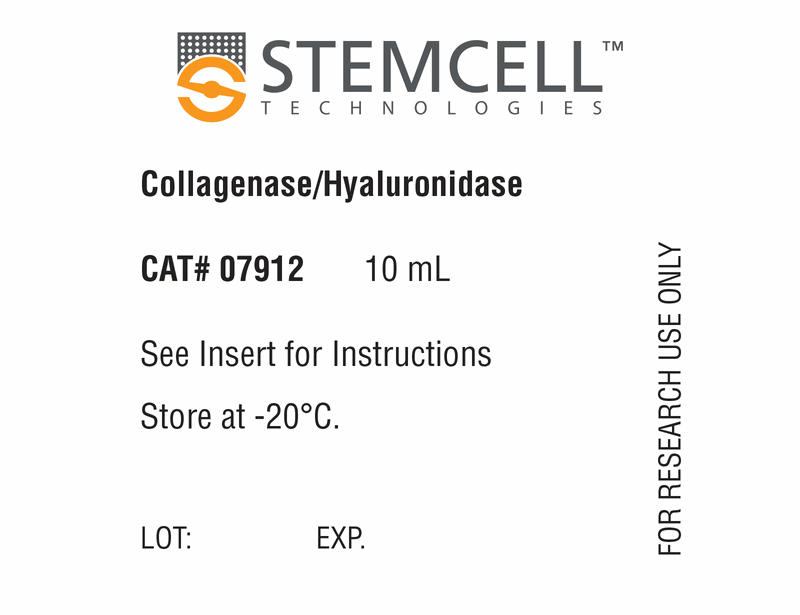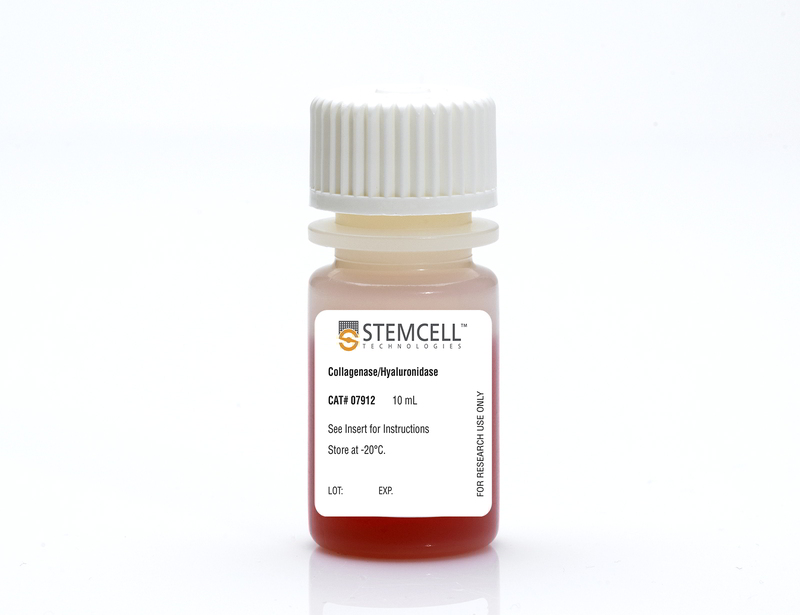Collagenase/Hyaluronidase
10X Collagenase/hyaluronidase in DMEM
概要
10X Collagenase/Hyaluronidase in Dulbecco’s Modified Eagle’s Medium (DMEM) for the enzymatic dissociation of human mammary tissue.
Contains
• 3000 U/mL Collagenase
• 1000 U/mL Hyaluronidase
• DMEM (1000 mg D-glucose/L)
• 1000 U/mL Hyaluronidase
• DMEM (1000 mg D-glucose/L)
Subtype
Enzymatic
Cell Type
Mammary Cells, Other, Prostate Cells
Species
Human, Mouse, Rat, Non-Human Primate, Other
Area of Interest
Epithelial Cell Biology
技术资料
| Document Type | 产品名称 | Catalog # | Lot # | 语言 |
|---|---|---|---|---|
| Product Information Sheet | Collagenase/Hyaluronidase | 07912 | All | English |
| Safety Data Sheet 1 | Collagenase/Hyaluronidase | 07912 | All | English |
| Safety Data Sheet 2 | Collagenase/Hyaluronidase | 07912 | All | English |
数据及文献
Publications (2)
Scientific reports 2015 SEP
Silica bioreplication preserves three-dimensional spheroid structures of human pluripotent stem cells and HepG2 cells.
Abstract
Abstract
Three-dimensional (3D) cell cultures produce more in vivo-like multicellular structures such as spheroids that cannot be obtained in two-dimensional (2D) cell cultures. Thus, they are increasingly employed as models for cancer and drug research, as well as tissue engineering. It has proven challenging to stabilize spheroid architectures for detailed morphological examination. Here we overcome this issue using a silica bioreplication (SBR) process employed on spheroids formed from human pluripotent stem cells (hPSCs) and hepatocellular carcinoma HepG2 cells cultured in the nanofibrillar cellulose (NFC) hydrogel. The cells in the spheroids are more round and tightly interacting with each other than those in 2D cultures, and they develop microvilli-like structures on the cell membranes as seen in 2D cultures. Furthermore, SBR preserves extracellular matrix-like materials and cellular proteins. These findings provide the first evidence of intact hPSC spheroid architectures and similar fine structures to 2D-cultured cells, providing a pathway to enable our understanding of morphogenesis in 3D cultures.
Cancer research 2011 MAR
Activation of the aryl hydrocarbon receptor AhR Promotes retinoic acid-induced differentiation of myeloblastic leukemia cells by restricting expression of the stem cell transcription factor Oct4.
Abstract
Abstract
Retinoic acid (RA) is used to treat leukemia and other cancers through its ability to promote cancer cell differentiation. Strategies to enhance the anticancer effects of RA could deepen and broaden its beneficial therapeutic applications. In this study, we describe a receptor cross-talk system that addresses this issue. RA effects are mediated by RAR/RXR receptors that we show are modified by interactions with the aryl hydrocarbon receptor (AhR), a protein functioning both as a transcription factor and a ligand-dependent adaptor in an ubiquitin ligase complex. RAR/RXR and AhR pathways cross-talk at the levels of ligand-receptor and also receptor-promoter interactions. Here, we assessed the role of AhR during RA-induced differentiation and a hypothesized convergence at Oct4, a transcription factor believed to maintain stem cell characteristics. RA upregulated AhR and downregulated Oct4 during differentiation of HL-60 promyelocytic leukemia cells. AhR overexpression in stable transfectants downregulated Oct4 and also decreased ALDH1 activity, another stem cell-associated factor, enhancing RA-induced differentiation as indicated by cell differentiation markers associated with early (CD38 and CD11b) and late (neutrophilic respiratory burst) responses. AhR overexpression also increased levels of activated Raf1, which is known to help propel RA-induced differentiation. RNA interference-mediated knockdown of Oct4 enhanced RA-induced differentiation and G(0) cell-cycle arrest relative to parental cells. Consistent with the hypothesized importance of Oct4 downregulation for differentiation, parental cells rendered resistant to RA by biweekly high RA exposure displayed elevated Oct4 levels that failed to be downregulated. Together, our results suggested that therapeutic effects of RA-induced leukemia differentiation depend on AhR and its ability to downregulate the stem cell factor Oct4.


